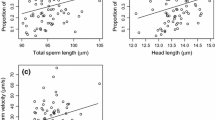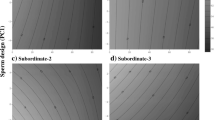Abstract
Sperm competition exerts strong selection on males to produce spermatozoa with an optimal morphology that maximizes their fertilization success. Long sperm were first suggested to be favored because they should swim faster. However, studies that investigated the relationship between sperm length and sperm competitive ability or sperm swimming velocity yielded contradictory results. More recently, ratios of the different sections of a spermatozoon (the head, midpiece, and flagellum) were suggested to be more crucial in determining swimming velocity. Additionally, sperm ability to remain and survive in the female storage organs may also influence fertilization success, so that optimal sperm morphology may rather maximize sperm longevity than velocity. In this study, we investigated how sperm morphology is related to sperm velocity and sperm longevity in the house sparrow Passer domesticus. Sperm velocity was found to be correlated with head/flagellum ratio. Sperm with small heads relative to their flagellum showed higher swimming velocity. Additionally, shorter sperm were found to live longer. Finally, we found sperm morphological traits to vary substantially within males and the head/flagellum ratio to be unrelated to total sperm length. We discuss the hypothesis that the substantial within-male variation in sperm morphology reflects a male strategy to produce a diversity of sperm from long, fast-swimming to short, long-living sperm to maximize their fertilization success in a context of sperm competition.



Similar content being viewed by others
References
Anderson MJ, Dixson AF (2002) Sperm competition: motility and the midpiece in primates. Nature 416:496
Birkhead TR, Brillard J-P (2007) Reproductive isolation in birds: postcopulatory prezygotic barriers. Trends Ecol Evol 22:266–272
Birkhead TR, Fletcher F (1995) Male phenotype and ejaculate quality in the zebra finch Taeniopygia guttata. Proc R Soc Lond B 262:329–334
Birkhead TR, Møller AP, Sutherland WJ (1993) Why do females make it so difficult for males to fertilize their eggs? J Theor Biol 161:51–60
Birkhead TR, Martinez JG, Burke T, Froman DP (1999) Sperm mobility determines the outcome of sperm competition in the domestic fowl. Proc R Soc Lond B 266:1759–1764
Briskie JV, Montgomerie R (1992) Sperm size and sperm competition in birds. Proc R Soc Lond B 247:89–95
Briskie JV, Montgomerie R, Birkhead TR (1997) The evolution of sperm size in birds. Evolution 51:937–945
Calhim S, Immler S, Birkhead TR (2007) Postcopulatory sexual selection is associated with reduced variation in sperm morphology. PLoS ONE 2:e413
Cardullo RA, Baltz JM (1991) Metabolic regulation in mammalian sperm: mitochondrial volume determines sperm length and flagellar beat frequency. Cell Motil Cytoskelet 19:180–188
Cornwallis CK, Birkhead TR (2007) Changes in sperm quality and numbers in response to experimental manipulation of male social status and female attractiveness. Am Nat 170:758–770
Dean R, Bonsall MB, Pizzari T (2007) Aging and sexual conflict. Science 316:383–384
Froman DP (2003) Deduction of a model for sperm storage in the oviduct of the domestic fowl (Gallus domesticus). Biol Reprod 69:248–253
Froman DP, Feltmann AJ (2000) Sperm mobility: phenotype in roosters (Gallus domesticus) determined by concentration of motile sperm and straight line velocity. Biol Reprod 62:303–309
Froman DP, Feltmann AJ, Rhoads ML, Kirby JD (1999) Sperm mobility: a primary determinant of fertility in the domestic fowl (Gallus domesticus). Biol Reprod 61:400–405
Froman DP, Pizzari T, Feltmann AJ, Castillo-Juarez H, Birkhead TR (2002) Sperm mobility: mechanisms of fertilizing efficiency, genetic variation and phenotypic relationship with male status in the domestic fowl, Gallus gallus domesticus. Proc R Soc Lond B 269:607–612
Gage MJG, Macfarlane C, Yeates S, Shackleton R, Parker GA (2002) Relationships between sperm morphometry and sperm motility in the Atlantic salmon. J Fish Biol 61:1528–1539
Gage MJG, Macfarlane CP, Yeates S, Ward RG, Searle JB, Parker GA (2004) Spermatozoal traits and sperm competition in Atlantic salmon: relative sperm velocity is the primary determinant of fertilization success. Curr Biol 14:44
García-Gonzáles F, Simmons LW (2007) Shorter sperm confer higher competitive fertilization success. Evolution 61:816–824
Gomendio M, Roldan ERS (1991) Sperm competition influences sperm size in mammals. Proc R Soc Lond B 243:181–185
Gomendio M, Roldan ERS (2008) Implications of diversity in sperm size and function for sperm competition and fertility. Int J Dev Biol 52:439–447
Helfenstein F, Szép T, Nagy Z, Kempenaers B, Wagner RH (2008) Between-male variation in sperm size, velocity and longevity in sand martins Riparia riparia. J Avian Biol 39:647–652
Holt C, Holt WV, Moore HDM, Reed HC, Curnock RM (1997) Objectively measured boar sperm motility parameters correlate with the outcomes of on-farm inseminations: results of two fertility trials. J Androl 18:312–323
Humphries S, Evans JP, Simmons LW (2008) Sperm competition: linking form and function. BMC Evol Biol 8:319
Immler S, Birkhead TR (2007) Sperm competition and sperm midpiece size: no consistent pattern in passerine birds. Proc R Soc Lond B 274:561–568
Immler S, Saint-Jalme M, Lesobre L, Sorci G, Roman Y, Birkhead TR (2007) The evolution of sperm morphometry in pheasants. J Evol Biol 20:1008–1014
Kleven O, Laskemoen T, Lifjeld JT (2009) Sperm length in sand martins Riparia riparia: a comment on Helfenstein et al. J Avian Biol 40:241–242
LaMunyon CW, Ward S (1998) Larger sperm outcompete smaller sperm in the nematode Caenorhabditis elegans. Proc R Soc Lond B 265:1997–2002
Laskemoen T, Kleven O, Fossoy F, Lifjeld JT (2007) Intraspecific variation in sperm length in two passerine species, the bluethroat Luscinia svecica and the willow warbler Phylloscopus trochilus. Ornis Fenn 84:131–139
Littell RC, Milliken GA, Stroup WW, Wolfinger RD, Schabenberger O (2006) SAS for mixed models, 2nd edn. SAS Institute, Cary
Lüpold S, Linz GM, Birkhead TR (2009a) Sperm design and variation in the New World blackbirds (Icteridae). Behav Ecol Sociobiol 63:899–909
Lüpold S, Calhim S, Immler S, Birkhead TR (2009b) Sperm morphology and sperm velocity in passerine birds. Proc R Soc Lond B 276:1175–1181
Malo AF, Gomendio M, Garde J, Lang-Lenton B, Soler AJ, Roldan ERS (2006) Sperm design and sperm function. Biol Lett 2:246–249
Minoretti N, Baur B (2006) Among- and within-population variation in sperm quality in the simultaneously hermaphroditic land snail Arianta arbustorum. Behav Ecol Sociobiol 60:270–280
Mossman J, Slate J, Humphries S, Birkhead TR (2009) Sperm morphology and velocity are genetically codetermined in the zebra finch. Evolution 63:2730–2737
Møller AP, Mousseau TA, Rudolfsen G, Balbontín J, Marzal A, Hermosell I, De Lope F (2009) Senescent sperm performance in old male birds. J Evol Biol 22:334–344
Nakagawa S (2004) A farewell to Bonferroni: the problems of low statistical power and publication bias. Behav Ecol 15:1044–1045
Nakagawa S, Ockendon N, Gillespie DOS, Hatchwell BJ, Burke T (2007) Assessing the function of house sparrows' bib size using a flexible meta-analysis method. Behav Ecol 18:831–840
Neff BD, Fu P, Gross MR (2003) Sperm investment and alternative mating tactics in bluegill sunfish (Lepomis macrochirus). Behav Ecol 14:634–641
Parker GA (1970) Sperm competition and its evolutionary consequences in the insects. Biol Rev 45:525–567
Parker GA (1998) Sperm competition and the evolution of ejaculates: towards a theory base. In: Birkhead TR, Møller AP (eds) Sperm competition and sexual selection. Academic, San Diego, pp 3–54
Pitcher TE, Rodd FH, Rowe L (2007) Sexual colouration and sperm traits in guppies. J Fish Biol 70:165–177
Pizzari T, Parker GA (2009) Sperm competition and sperm phenotype. In: Birkhead TR, Hosken DJ, Pitnick S (eds) Sperm biology: an evolutionary perspective. Academic, San Diego, pp 207–245
Pizzari T, Jensen P, Cornwallis CK (2004) A novel test of the phenotype-linked fertility hypothesis reveals independent components of fertility. Proc R Soc Lond B 271:51–58
Pizzari T, Cornwallis CK, Froman DP (2007) Social competitiveness associated with rapid fluctuations in sperm quality in male fowl. Proc R Soc Lond B 274:853–860
Pizzari T, Worley K, Burke T, Froman D (2008a) Sperm competition dynamics: ejaculate fertilising efficiency changes differentially with time. BMC Evol Biol 8:332
Pizzari T, Dean R, Pacey A, Moore H, Bonsall MB (2008b) The evolutionary ecology of pre- and post-meiotic sperm senescence. Trends Ecol Evol 23:131
Rudolfsen G, Figenschou L, Folstad I, Tveiten H, Figenschou M (2006) Rapid adjustments of sperm characteristics in relation to social status. Proc R Soc Lond B 273:325–332
SAS® (2003) In, vol 9.1, 9.1 edn. SAS Institute, Cary
Stockley P, Gage MJG, Parker GA, Møller AP (1997) Sperm competition in fishes: the evolution of testis size and ejaculate characteristics. Am Nat 149:933–954
Vladić TV, Järvi T (2001) Sperm quality in the alternative reproductive tactics of Atlantic salmon: the importance of the loaded raffle mechanism. Proc R Soc Lond B 268:2375–2381
Wedell N, Gage MJG, Parker GA (2002) Sperm competition, male prudence and sperm-limited females. Trends Ecol Evol 17:313–320
Wilson-Leedy JG, Ingermann RL (2007) Development of a novel CASA system based on open source software for characterization of zebrafish sperm motility parameters. Theriogenology 67:661–672
Wolfson A (1952) The cloacal protuberance—a means for determining breeding condition in live male passerines. Bird Banding 23:159–165
Acknowledgments
We are very grateful to Dr. Beat Wampfler for allowing us to work in the Nationales Pferdezentrum Bern. The authors would also like to thank the two anonymous referees for their valuable comments on the manuscript. This work was conducted under license of the Ethical Committee of the Agricultural Office of the Canton Bern and a ringing permit provided by the Agency for Environment, Forests, and Landscapes.
Authors’ contributions
FH designed the study, collected the data, and analyzed sperm motility; MP measured sperm; FH and MP analyzed data and wrote the paper; and HR supervised the study. This study was part of MP's bachelor's work.
Author information
Authors and Affiliations
Corresponding author
Additional information
Communicated by R. Gibson
Rights and permissions
About this article
Cite this article
Helfenstein, F., Podevin, M. & Richner, H. Sperm morphology, swimming velocity, and longevity in the house sparrow Passer domesticus . Behav Ecol Sociobiol 64, 557–565 (2010). https://doi.org/10.1007/s00265-009-0871-x
Received:
Revised:
Accepted:
Published:
Issue Date:
DOI: https://doi.org/10.1007/s00265-009-0871-x




